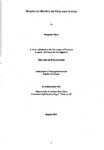MAGNETIC DATING OF VESUVIAN LAVAS
| dc.contributor.author | Tiano, Pasquale | |
| dc.contributor.other | Faculty of Science and Engineering | en_US |
| dc.date.accessioned | 2013-10-07T09:31:38Z | |
| dc.date.available | 2013-10-07T09:31:38Z | |
| dc.date.issued | 2001 | |
| dc.identifier | NOT AVAILABLE | en_US |
| dc.identifier.uri | http://hdl.handle.net/10026.1/2045 | |
| dc.description.abstract |
A palaeomagnetic study has been carried out on Vesuvian lava flows emplaced since 79 AD. This involved both palaeodirection and palaeointensity investigations of samples from sites on the W, S and SE slopes of the volcano. Thermal demagnetization of 3 component IRMs, susceptibility measurements and coercivity analyses have been carried out on one pilot specimen per site in order to identify the magnetic carriers and to estimate the magnetic grain size. The identificatìon of the primary direction of TRM was carried out following very stringent criteria (Incoronato, 1996). Palaeointensities were evaluated using both a modification of the Modified Thellier & Thellier method (McClelland et al., 1996) and the innovatìve microwave technique (Shaw et al., 1999). This study has shown that establishing whether or not different exposures or flows are contemporaneous can be established and, in most, but not all, cases can be undertaken successfully using magnetic information recorded by Vesuvian lavas to define the geomagnetic field direction and intensity at the time of their eruption. It is shown that numerous lava flows, outcropping on the W to S slopes of the volcano, must be associated to a large eruption in AD 1631, confirming some previous studies. A new age for a lava flow, ascribed in literature to the 1697 event, is suggested on the basis of both palaeodirection and palaeointensity investigations. Significantly different properties have been found between microwave and thermal experiments although they showed an exceptional level of agreement for the AD 1631 lava flow. In general the trend the palaeointensity variations was similar to that obtained by thermal processes for the last few centuries from other European, Mediterranean and Near East regions (Aitken et al., 1989). | en_US |
| dc.description.sponsorship | Dipartimento di Scienze della Terra Università' degli Studi di Napoli "Federico H" | en_US |
| dc.language.iso | en | en_US |
| dc.publisher | University of Plymouth | en_US |
| dc.title | MAGNETIC DATING OF VESUVIAN LAVAS | en_US |
| dc.type | Thesis | |
| plymouth.version | Full version | en_US |
| dc.identifier.doi | http://dx.doi.org/10.24382/4154 |
Files in this item
This item appears in the following Collection(s)
-
01 Research Theses Main Collection
Research Theses Main


